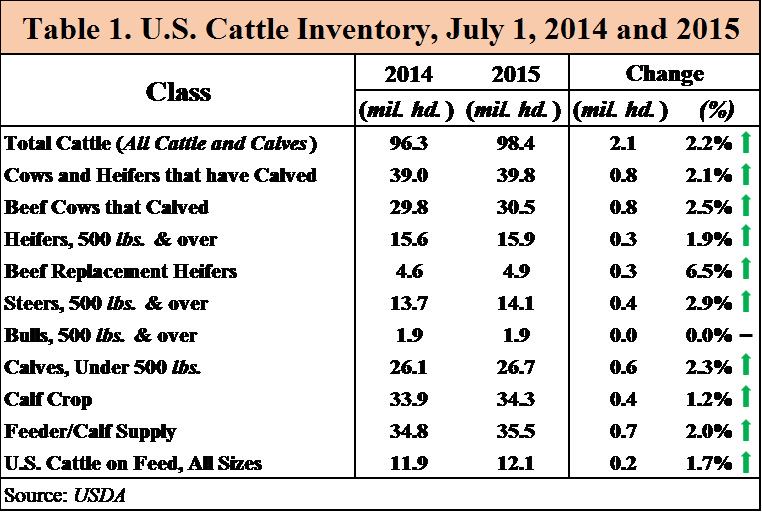U.S. Cattle Inventory Report for July 2015
Cow-herds are still expanding in the U.S.
By: Chris Prevatt, University of Florida
The semi-annual U.S. Cattle Inventory Report was released on July 24, 2015 by the National Agricultural Statistics Service (NASS). This report confirmed that U.S. herd expansion is continuing. The report saw significant increases in every category except the category of Bulls, 500-pounds and over which remained unchanged from a year ago, as shown in Table 1.
The Total Cattle Inventory (All Cattle and Calves) in the U.S. as of July 1, 2015 totaled 98.4 million head, increasing by 2.1 million head (2.2%) above the 96.3 million head on July 1, 2014. Cows and heifers that have calved totaled 39.8 million head, increasing by 800,000 head (2.1%). The nation’s beef cow herd (Beef Cows that Calved) totaled 30.5 million head, increasing by 750,000 head (2.5%) above July 1, 2014. This level of growth suggests that more cows are being retained in the cowherd. This trend is expected to continue for the remainder of 2015 and likely well into next year due to continued improvement in pasture and range conditions and strong cow-calf profitability sending signals to cow-calf producers to increase their herd size.
Heifers, 500-pounds and over totaled 15.9 million head, an increase of 300,000 head compared with a year-ago. Beef Replacement Heifers grew by 300,000 head (6.5%) to 4.9 million head from last year’s mid-year report. This is the largest percentage increase since 1986 which confirms that cow-calf producers are growing their herds through heifer retention. Steers, 500-pounds and over totaled 14.1 million head, an increase of 400,000 head (2.9%). Bulls, 500-pounds and over were unchanged from a year-ago at 1.9 million head.
Calves, under 500-pounds totaled 26.7 million head, an increase of 600,000 head (2.3%) compared with July 1, 2014. The Calf Crop totaled 34.3 million head, increasing by 400,000 head (1.2%) from a year ago. Feeder/Calf Supply totaled 35.5 million head, increasing by 700,000 head (2.0%). The U.S. Cattle on Feed, All Sizes was 12.1 million head, increasing by 200,000 (1.7%) head from a year-ago.
The U.S. calf crop has shown a continuous decline from 40.3 to 33.7 million head (-19.4%) between 1995 and 2013, as shown in Figure 1. The U.S. calf crop documented increases in 2014 and 2015 which totaled 570,000 head (1.7%). The last time the calf crop grew in two consecutive years was 20 years ago during 1994-1995 which was the last major herd expansion phase.
The U.S. cattle cycle finally appears to be turning the corner with larger calf crops and cattle inventory numbers. The results of the January 1 and July 1 cattle inventory reports have made it clear that expansion is taking place by retaining more beef cows and replacement heifers. This continued beef herd expansion will be moderately bearish on cattle prices during the next couple of years. Remember, that changes in cattle inventory will be slow due to the size of the beef industry and the reproductive biology of cattle.







